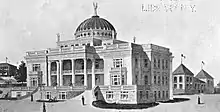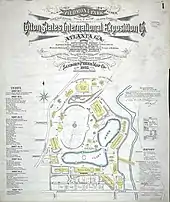Cotton States and International Exposition
The 1895 Cotton States and International Exposition was held at the current Piedmont Park in Atlanta, Georgia, United States. Nearly 800,000 visitors attended the event. The exposition was designed to promote the American South to the world and showcase products and new technologies, as well as to encourage trade with Latin America. The Cotton States and International Exposition featured exhibits from several states including various innovations in agriculture and technology. President Grover Cleveland presided over the opening of the exposition. The event is best remembered for the "Atlanta compromise" speech given by Booker T. Washington on September 18, promoting racial cooperation.
| Cotton States and International Exposition | |
|---|---|
 Exhibit buildings | |
| Overview | |
| BIE-class | Unrecognized exposition |
| Name | Cotton States and International Exposition |
| Visitors | 800 000 |
| Participant(s) | |
| Countries | 13 |
| Location | |
| Country | United States |
| City | Atlanta, Georgia |
| Venue | Piedmont Park (now) |
| Coordinates | 33°47′05″N 84°22′30″W |
| Timeline | |
| Opening | September 18, 1895 |
| Closure | December 31, 1895, attracted visitors from the U.S. and 13 countries |


Background
The idea for an international exposition in Atlanta was first proposed by former mayor of Atlanta William Hemphill in November 1893. He would serve as the vice president and director of the exposition.[1][2]
Overview
The Exposition was open for 100 days, beginning on September 18, 1895 and ending December 31, 1895, attracted visitors from the U.S. and 13 countries.[3] Over $2,000,000 was spent on the transformation of Piedmont Park.[4] The government allocated $250,000 for the construction of a government building and many states and countries such as Argentina also had their own buildings.[5] Also constructed for the fair were the Tropical gardens, now known as the Atlanta Botanical Garden, and Lake Clara Meer which was originally a pond but was expanded to 11.5 acres (47,000 m2) for the event.[6] Today, the stone balustrades scattered around the park are the only remaining part of the enormous main building.[6] The park remains largely as Joseph Forsyth Johnson designed it for the exposition. The supervising architect for the entire fair was Bradford Gilbert.
Exhibits
The exposition included many exhibits in the categories of Minerals and Forestry, Agriculture, Food and Accessories, Machinery and Appliances, Horticulture, Machinery, Manufactures, Electricity, Fine Arts, Painting and Sculpture, Liberal Arts, Education and Literature. Pennsylvania's first woman American architect, Elise Mercur (1864–1947) designed the Woman's Building of the Cotton States and International Exposition, a Palladian style building constructed for the purpose of displaying the accomplishments of women.[7] About six thousand exhibits were examined and beautifully designed medals were awarded. The Awards Committee awarded a total of 1,573 medals: 634 gold medals, 444 silver medals, and 495 bronze medals.[8] In late September Charles Francis Jenkins demonstrated an early movie projector called the "Phantoscope."
John Philip Sousa composed his famous march, King Cotton, for the exposition, and dedicated it to the people of the state of Georgia.
Walter McElreath described it in his memoirs:[9]
The railroad yards were jammed every morning with trains that brought enormous crowds. The streets were crowded all day long. Every conceivable kind of fakir bartered his wares. Dime museums flourished on every street.... Vast stucco hotels stood on Fourteenth Street.... I spent a great deal of time on the streets looking at the strange crowds -- American Indians, Circassians, Hindus, Japanese, and people from every corner of the globe -- who had come as professional midway entertainers or fakirs.
December 26, 1895, was Negro Day at the Expo.[10] Famed African American quilter Harriet Powers also attended this day and met with Irvine Garland Penn, the chief of the Negro Building at the Expo.[11]

The Women's Building exhibitions were curated by women from Georgia. The contents where contributed by women around the country. Women culled historical artifacts, decorative arts objects, and industrial products to compose displays in each room, including the Baltimore Room, the Lucy Cobb Room, Mary Ball Washington Tea Room, the Columbus Room, Model Library, Assembly Hall, and others, each assigned to a different state. The National League of Mineral Painters, an organization of members such as Adelaïde Alsop Robineau and Mary Chase Perry, contributed decorative objects and artwork to the New York City section. The unifying objective was to showcase the accomplishments of women throughout the South, and the country, in the areas of education, health care, and the fine and decorative arts. The many elaborate displays reflected a diversity of views spanning the mainstream social and domestic roles of Southern women, such as patriotism and the ideals of traditional motherhood to little known achievements of women counter to mainstream stereotypes.[12] The Legion of Loyal Women display, for example, presented an arrangement of 45 dolls, each one adorned with a small shield showing the name of a state, to illustrate the American Patriotic salute. Other displays posed a challenge to the roles of women and other social conventions. The Colonial Room presented utensils and furnishings, as well as Dolly Madison's spectacles, a gun carried in the Battle of Concord, and brass medallions belonging to George Washington; the display was said to represent "the growing bond of cooperation between the North and South." [13] The Exposition in the Women's Building thus introduced new ideas to foster trade and collaboration between the southern states and Northern states, and to also show ideas, products, and facilities to the rest of the nation and to Europe.[14] The Exhibitions presented prototypes of a hospital room, nursery, kindergarten classroom, and a model library, each one in actual working order. These functional rooms, representative of environments where women played an important roles outside the home and family, equipped with the most up-to-date equipment, features, and furnishings. The model library included an actual collection of publications by women authors from every state in the nation, and a photography exhibition of the portraits of women in every branch of literature, each appended with a verse, letter, or section of a manuscript.[15]
Booker T. Washington's speech
The Cotton States and International Exposition Speech was an address on the topic of race relations given by Booker T. Washington on September 18, 1895, at the exposition in Atlanta. The speech laid the foundation for the Atlanta compromise, an agreement between African-American leaders and Southern white leaders in which Southern blacks would work meekly and submit to white political rule, while whites guaranteed that blacks would receive basic education and due process of law. The speech was presented before a predominantly white audience[16] and has been recognized as one of the most important, influential, and controversial speeches in American history.[17]
Legacy
After the exposition, the grounds were purchased by the City of Atlanta and became Piedmont Park and the Atlanta Botanical Garden.
Gallery
 Map of the Expo
Map of the Expo Lithograph of Piedmont Park plans for the 1895 World's Fair in Atlanta, GA
Lithograph of Piedmont Park plans for the 1895 World's Fair in Atlanta, GA
References
- Cooper, Walter Gerald (1896). The Cotton States and International Exposition and South, Illustrated. Illustrator Company. p. 143 – via Google Books.
- "William Arnold Hemphill collection, 1898-1902". Emory University Libraries. June 13, 2007. Retrieved December 28, 2019.
- "Atlanta:Piedmont Park". Atlanta:A National Register of Historic Places Travel Itinerary. National Park Service. Archived from the original on May 3, 2008. Retrieved June 5, 2008.
- "FOR ATLANTA'S BIG SHOW" (PDF). New York Times Online. The New York Times. August 1, 1895. Retrieved June 5, 2008.
- "Session 3: Address to the Country". The Progress of a People: A Special Presentation of the Daniel A. P. Murray Pamphlet Collection. Library of Congress. October 19, 1998. Retrieved June 5, 2008.
- "Park History". Piedmont Park Conservancy. Archived from the original on May 4, 2007. Retrieved May 30, 2007.
- Branton, Harriet (April 23, 1983). "Forgotten Lady Architect". Observer Reporter.
- "Exposition Medals". Medals of Atlanta Cotton States and International Exposition of 1895. Retrieved July 26, 2009.
- McElreath, Walter, An Autobiography, Mercer University Press, p.129-130
- "This is Negro Day," Atlanta Constitution December 26, 1895, p. 5
- "This I Accomplish: Harriet Powers' Bible Quilt and Other Pieces, by Kyra E. Hicks, Black Threads Press, 2009, p. 40-41.
- Bruce Harvey, Bruce; Watson-Powers, Lynn (1995). "The Eyes of the World Are Upon Us: A Look at the Cotton States and International Exposition of 1895". Atlanta History. 39: 5–11.
- Pollack, Deborah C. (2015). Visual Art and the Urban Evolution of the New South. University of South Carolina Press. p. 400. ISBN 9781611174328.
- Johnson, Joan Marie (2004). Southern Ladies, New Women: Race, Region, and Clubwomen in South Carolina, 1890-1930. Gainesville, Florida: University of Florida Press. p. 282. ISBN 9780813037103.
- Washington, Booker T. (1896). "Report of the Board of Commissioners representing the state of New York at the Cotton States and International Exposition held at Atlanta, Georgia, 1895". Albany, N.Y.: Wynkoop Hallenbeck Crawford Co., State Printers: 302 pages : illustrations, portraits, 27 cm. OCLC 4197235. Cite journal requires
|journal=(help) - Text of Atlanta Compromise Speech
- "Atlanta Compromise Speech". New Georgia Encyclopedia. Retrieved June 8, 2007.
Further reading
- Mullis, Sharon M. (Fall 1976). "Extravaganza of the New South: The Cotton States and international Exposition, 1895". Atlanta Historical Bulletin. Atlanta Historical Society. 20 (3): 17–36 – via Atlanta History Center.
- Perdue, Theda. Race and the Atlanta Cotton States Exposition of 1895 (2010).
- Cardon, Nathan. "The South's 'New Negroes' and African American Visions of Progress at the Atlanta and Nashville International Expositions, 1895-1897" Journal of Southern History (2014).
- Cardon, Nathan. A Dream of the Future: Race, Empire, and Modernity at the Atlanta and Nashville World's Fairs (Oxford University Press, 2018).
External links
| Wikisource has the text of the 1905 New International Encyclopedia article "Atlanta Exposition". |
- Fred L. Howe 1895 Cotton States and International Exposition Photographs from the Atlanta History Center
- Cotton States Exposition of 1895 historical marker
- Jenkins projector
- Cotton Expositions in Atlanta, New Georgia Encyclopedia